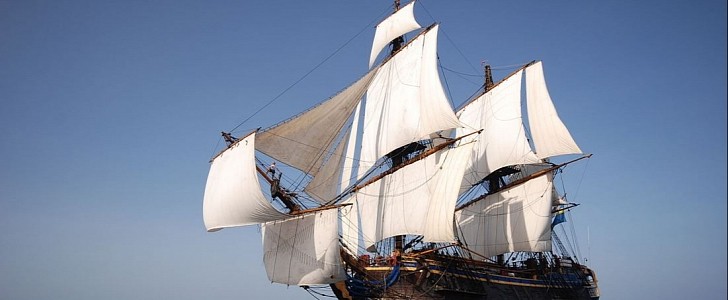In a world where all eyes are on the technology of the future, a Swedish company has looked into the past and brought back to life a piece of history, by recreating the replica of an 18th century wooden sailing ship, from scratch. Now, that ship is becoming an ambassador for a sustainable maritime industry.
SOIC Ship Management succeeded in building an 18th-century ship in full 1:1 scale, by using the materials, manufacturing techniques and tools that were available at that time. Gotheborg of Sweden II, fully operational, became the largest sailing wooden ship today. It took many years for the design to be developed without the help of any original drawings, but the ship eventually came to life in 2005.
The company’s next ambitious goal is for Gotheborg II to sail on the same path its predecessor did, following the old trading route from Sweden to China. The journey is set to begin in April 2022 and end in Shanghai, by October the same year. In preparation for that historical sailing trip, the ship has arrived in Stockholm at the end of August, where it will remain until September 4.
Although this majestic vessel is a tribute to the 18th century wooden version, it still has to take into consideration modern times requirements. By using just its sails, Gotheborg would not be able to reach its destination in the short 7-month period, which is why it’s equipped with engines.
However, during this recent trip to Sweden, Gotheborg used biodiesel made from rapeseed oil, instead of conventional marine diesel, in two of its four fuel tanks. This is the first step in SOIC Ship Management’s commitment to minimizing the ship’s environmental impact. During the trial of the RME biofuel, for safety reasons, conventional fuel was also used in the other two fuel tanks.
It might look like a small step, but it’s a big deal for the maritime industry, where the transition to sustainable fuels is still painfully slow. The plan is for Gotheborg to use alternative fuels during its upcoming Asian expedition. With the wooden sailing ship being already quite popular, this would help spread the message across the industry and maybe help accelerate the transition to sustainable ships.
The company’s next ambitious goal is for Gotheborg II to sail on the same path its predecessor did, following the old trading route from Sweden to China. The journey is set to begin in April 2022 and end in Shanghai, by October the same year. In preparation for that historical sailing trip, the ship has arrived in Stockholm at the end of August, where it will remain until September 4.
Although this majestic vessel is a tribute to the 18th century wooden version, it still has to take into consideration modern times requirements. By using just its sails, Gotheborg would not be able to reach its destination in the short 7-month period, which is why it’s equipped with engines.
However, during this recent trip to Sweden, Gotheborg used biodiesel made from rapeseed oil, instead of conventional marine diesel, in two of its four fuel tanks. This is the first step in SOIC Ship Management’s commitment to minimizing the ship’s environmental impact. During the trial of the RME biofuel, for safety reasons, conventional fuel was also used in the other two fuel tanks.
It might look like a small step, but it’s a big deal for the maritime industry, where the transition to sustainable fuels is still painfully slow. The plan is for Gotheborg to use alternative fuels during its upcoming Asian expedition. With the wooden sailing ship being already quite popular, this would help spread the message across the industry and maybe help accelerate the transition to sustainable ships.









